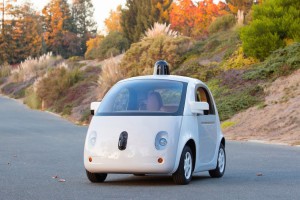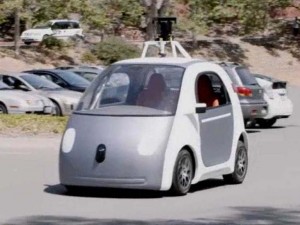
Google's self-driving car took another step toward reality as the company used prototypes to give a focus group a few test drives.
Christmas came a few days early for the folks developing Google’s Self-Driving Car as they rolled out working prototypes of the car for people to test drive…or in this case, test ride.
The company released a photo as well as a video titled “A First Drive” featuring of a variety of folks getting a chance to go for a spin in the cars.
“It was cool,” said a woman named Thida in the video. “It was kind of a space age experience.”
This is really a second debut for the cars. Google showed off non-functional versions in May, but the project team has been busy since then.
“We’ve been working on different prototypes-of-prototypes, each designed to test different systems of a self-driving car – for example, the typical “car” parts like steering and braking, as well as the “self-driving” parts like the computer and sensors,” the company said in a statement. “We’ve now put all those systems together in this fully functional vehicle – our first complete prototype for fully autonomous driving.”
That said, the cars do not look dramatically different than what was shown earlier this year. On the inside, the interiors are pretty sparse, but they look relatively comfortable with plenty of room for two passengers. They also feature manual controls that allow the cars to be driven “off the grid.”
Google plans to continue shaking out the cars on its test track and then move to the streets of Northern California. Chris Urmson, director, Google Self-Driving Cars, said putting people in the vehicles represents tremendous progress in a short time.
“It was a big decision for us to go an start building our purpose-built vehicles,” he said in the video. “Really, they’re prototype vehicles. They were a chance for us to explore what does it really mean to have a self-driving vehicle. But in the small amount of time we’ve been working on it and we have functional prototypes. It’s exciting.
“This is a first step for us and it’s really exciting to see the progress we’ve made. The opportunity for people to just move around and not worry about it, it’s going to be incredibly empowering and incredibly powerful for people.”
(Motorists like concept, but wary of self-driving cars. For more, Click Here.)
The test group featured a diverse set of people ranging from a young boy to senior citizens to a blind gentleman named Steve, who agreed with Urmson: a self-driving vehicle would open a whole new world for him.
“Our lives are made up of lots and lots of little things. And a lot of those little things for most people involve getting from place to place,” he said in the video. “In order to connect and do things and be with people and go places that they need to go and do things. So there is a big part of my life that’s missing. And there is a big part of my life that a self-driving vehicle would bring back to me.”
(Click Here for details about high-tech safety features drivers want in their cars.)
Virtually every major automaker is working on some form of autonomous driving system. Toyota sees the technology as a way to assist drivers – who would remain in control – while Japanese rival Nissan plans to have a fully self-driving vehicle on the road by 2020. Cadillac, meanwhile, plans to introduce its SuperDrive system on the planned CT6 flagship sedan in 2016, but it will only allow hands-free driving on limited access highways.
However, many vehicles feature safety technologies currently available – and desired – on vehicles that are the springboard for self-driving vehicles. While surveys show consumers want more safety technologies on new cars, they’re not necessarily as eager to turn the driving over completely.
(To see why new vehicle sales will exceed 17 million units next year, Click Here.)
Only 29% of those surveyed by AutoPacific, Inc. said they would want to eventually own an autonomous vehicle. Among those who wouldn’t want one, four out of five said they simply prefer to drive themselves. About half cited liability issues, with an equal number concerned the technology would simply be too expensive. Others raised questions about reliability, safety and the cost of repairs.
As to those who would want to own an autonomous vehicle, seven out of 10 said they like the idea of being able to relax while driving, 66% saying they expect the technology to improve highway safety. Reducing stress and improving fuel-economy were other factors, while more than one in three said they would like the opportunity to be able to work or multi-task rather than having to focus on driving duties.


I wonder what crash test specifications currently exist for these “to be” autonomous vehicles with passenger seating positions being all sorts of different combinations. Basically each person/seat will need a safety capsule to protect them in the event of a crash that can occur from any direction.
There is currently an ethics committee being formed to discuss what the official approved procedure will be for programming the vehicles computers so that in the event of a no win crash situation, what the agreed response will need to be of the computers. In other words if someone is going to die no matter what the autonomous vehicle does, who will die or what fatal decision will the computer chose. It’s no trivial task to decide who will die… and I’m sure the lawyers will profit no matter what choices are made.
Big deal. Driving in a parking lot is a lot different than driving on I-94 in rush hour.
This project is going to go no where fast. Its a nice bonus for Roush though. It gives them the opportunity to screw a customer that knows absolutely nothing about designing and building cars. And at the end of the day, once again, they get to blame the customer for being stupid.
Self driving cars will be a blessing for people who are getting close to the age where they will have give up their keys but don’t want to lose their independence but before any of these cars become a reality they’ve get to find a way to make them hack proof.
Let’s see, Hackers have managed to hit Target, Home Depot, Sony, UCLA , and almost any other “Name” retailer. Cyber wars are the new “battle field” and you want to turn over control of your car to a computer? What can possibly go wrong with this scenario? The only advantage I see is now the ones who drive trying to post what they had for lunch on facebook, can do this now without being interrupted.
I don’t even like riding in a car that someone else is driving, much less by an invisible” driver. Just because we “discover” technology doesn’t make it best for the masses.
Other than the noted liabilities from hackers, etc. who have also already compromised digital auto security systems… I do see properly designed, engineered and manufactured autonomous vehicles as helping those folks who do not have access to good public transportation or who desire to maintain their personal independence as they age – which would be most folks who currently drive. It also might be a God send if we could get the clowns who text and talk on their phones while driving, to buy these cars. The possibility of reduced accidents could be significant – if and only if the cars are properly engineered, built and programmed. One minor programming error could be the downfall of the entire fleet however.
If North Korea (or anyone else), can hack these cars like they did Sony, then we’re all in deep trouble.
There are numerous significant issues to be resolved before it would be reasonable or prudent to allow autonomous vehicles on the roadways.